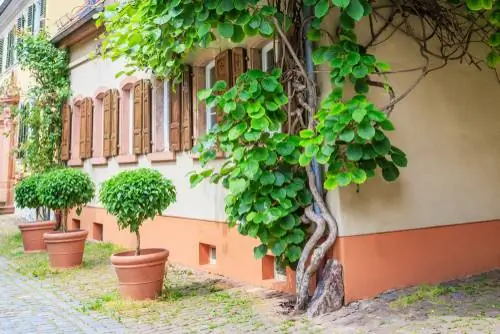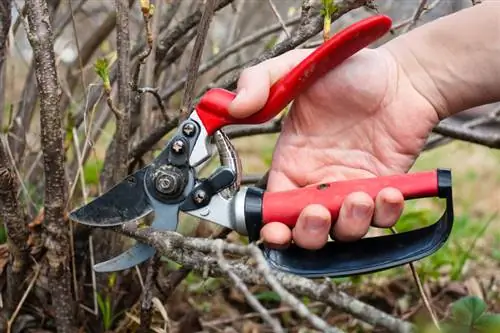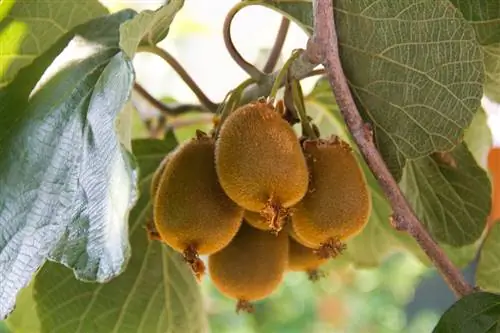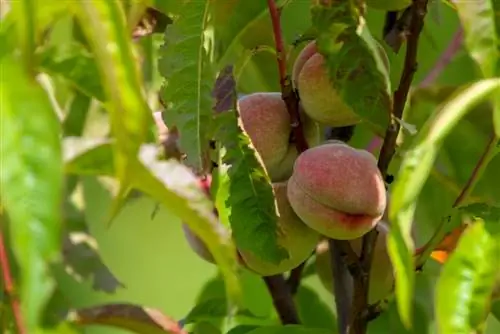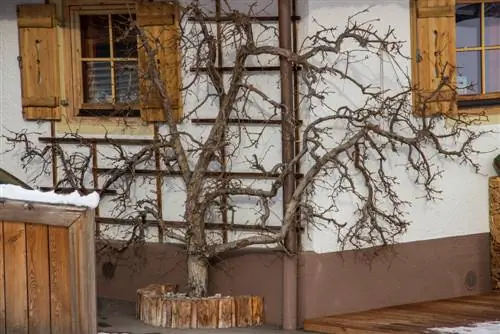- Author admin [email protected].
- Public 2023-12-24 06:09.
- Last modified 2025-06-01 06:02.
Growing your own refreshing kiwi will be a successful project if a gardener knows how to care for the pruning properly. To ensure that the Far Eastern creeper blooms magnificently in spring and produces a rich harvest in autumn, you should train your kiwi skillfully and prune it twice a year. This applies equally to self-fertile varieties and mixed doubles. You can read practical instructions with useful tips and tricks in this tutorial.
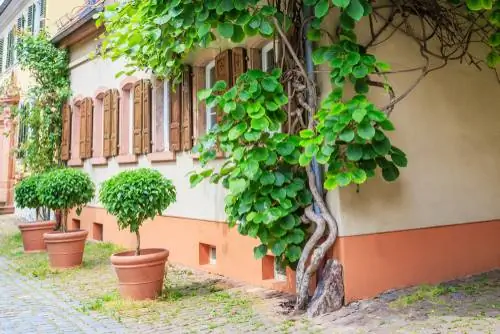
How should you cut kiwis correctly?
To prune kiwis correctly, carry out training pruning in the 1st and 2nd year, summer pruning from the 3rd year and spring pruning from the 4th year. In this way you promote the growth of fruit wood, better harvest yields and avoid damage.
Cutting kiwi - cutting types and dates
Kiwis thrive as left-winding creepers with an annual growth of up to 100 centimeters. A strategictraining on the trellisis just as essential for a rich harvest as acut twice a year Kiwi plants bloom and bear fruit on long, annual shoots. Fruiting long shoots sprout from the previous year's short shoots, which in turn are supported by a permanent framework. The following table summarizes which types of cutting you can use to properly care for a kiwi:
| Cut style | Goal/Occasion | best date |
|---|---|---|
| Educational Cut | optimal structure on the trellis | 1. and 2nd year in spring and summer |
| Summer cut | Improve crop yield, promote fruit wood | from the 3rd year in summer |
| Spring cut | thin out old fruit wood, regulate growth | from the 4th year in spring |
Raising kiwis in an exemplary manner
Kiwi plants rely on a stable climbing aid. A wire trellis on the south wall of the house requires little effort. Stretch three thick wires horizontally, each 50 to 80 centimeters apart. Attach the lowest wire at a height of 80 centimeters. A distance from the wall of 7 to 8 centimeters has proven to work well. In the first two years, pruning care is dedicated to clear and productive training. How to do it right:
Education first year
- In the spring after planting, select the strongest shoot as the main shoot
- Cut back the main shoot by a third or half just above an undamaged bud
- Cut off all remaining ground shoots (if any) at the base
- Tie side shoots growing from the main shoot horizontally to the trellis
In the first year, train your kiwi with a framework of main shoots and side shoots, which you tie horizontally to the wires on both sides. Only cut back the scaffolding tendrils when they have reached the end of the trellis.
Education second year
In the second year, the first side shoots form on the horizontal leading branches. These will produce fruiting long shoots from the third year onwards. Prune the first side shoots several times during the summer to a length of four to six leaves. The resulting sap buildup makes a valuable contribution to later branching with fruit wood.
Background
Horizontal scaffold shoots benefit from the law of growth
The law of top support teaches us that fruit trees only produce valuable fruit wood if their shoots are in aoblique to horizontal orientation. The fruit wood on a kiwi is short-lived and is not part of the supporting structure. In order for it to grow, the main branches must be motivated to first sprout short shoots from which the fruiting long shoots grow. As long as a shoot is tightly upright, its juices strive towards the tip bud, which is at the expense of branching. By tying the lateral leading branches of the central shoot horizontally to the right and left, you create the basis for the growth of short shoots and their fruiting long shoots this year.
Summer pruning optimizes crop yield
In the third year, pruning care moves from education to maintenance. At the beginning of the growth period, the first fruit shoots form, which bear the longed-for flower buds in the inner four or five leaf axils. Summer pruning is dedicated to the long fruit tendrils. How to do it professionally:
- Short long shoots down to4 leaves behind the last flower bud
- Break out branches emerging from the interface by hand in the same summer
- Cut extensions on the leading branches back to 150 to 200 centimeters and tie them again
In summernot trimmed will be young, this year's shoots that sprout along the horizontal scaffold branches. These are new short shoots that will form the valuable, long fruit wood next year.
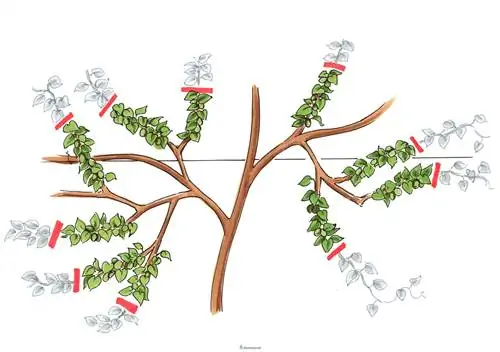
Fruiting long shoots are cut back in summer to six to eight leaves behind the last fruit. Break out any side shoots that develop below an interface.
Spring pruning promotes fruit wood
During spring pruning, worn, frozen and dead shoots are the center of attention. A courageous pruning ensures order and clears the way for fresh long shoots that will bloom and bear fruit this year. This is how you do an exemplary spring pruning on your kiwi:
- Cut empty fruit canes to 5 cm short stubs
- Cut back frozen branches to he althy wood
- Cut off dead wood on a branch
- Cut back last year's growth on the scaffolding shoots and tie it again
- Thin out branches that are growing too densely so that future fruit tendrils are not shaded in summer
- Previous year's short shootsdo not cut
As illustrated below, do not completely cut off worn fruit wood. The task of the short cones is to branch out from sleeping eyes and in this way form new short shoots.
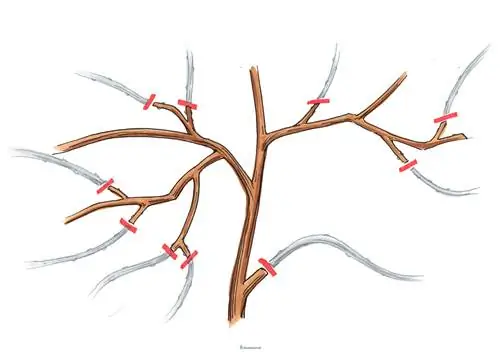
In spring, worn fruit tendrils are shortened to 5 centimeter short cones. Last year's growth in scaffolding shoots is cut back to a length of 50 to 100 centimeters and is tied to the trellis. Thin out frozen and dead tendrils.
Excursus
Achilles heel short shoots - protection against late frosts is key
On a kiwi, this year's fruit wood comes from last year's short shoots. This makes the short shoots vulnerable to late frosts in April and May. In an emergency, either no fruiting long shoots sprout at all or long shoots grow without flowers. All efforts to ensure professional pruning care are then wasted - at least for this year’s harvest. Keep an eye on the weather forecast. If meteorologists predict nighttime temperatures below freezing, cover your kiwi plant with a fleece. This protects the valuable short shoots with the buds from frostbite.
Frequently asked questions
Are kiwi plants self-fertile?
The majority of kiwi varieties thrive as dioecious plants. Specifically, this means that male or female flowers form on separate plants. A female kiwi can only fruit if its flowers are fertilized by male pollen. Newer varieties are self-fertile, such as the well-known kiwi varieties 'Solo' or 'Jenny', because they have male and female flowers. The yield is of course significantly higher if there is another male plant nearby.
Last year I planted a self-fertile kiwi variety that bore fruit the year it was planted. The berries are very small, measuring 2.5 centimeters in diameter. What can I do to make the fruit bigger?
For a kiwi plant to bear large fruits, it depends on a sunny, warm location and loose, airy, light-flooded growth. Prune the creeper in spring and summer to encourage fruiting wood growth. In addition, from April to July we recommend an organic nutrient supply with compost (€10.00 on Amazon) and horn shavings in the bed or liquid berry fertilizer in the bucket. At the end of July, the application of fertilizer ends with a potassium-concentrated autumn fertilizer, such as potash magnesia or patent potash.
My kiwi has been in a sub-optimal location for two years. Can I transplant the kiwi now in October?
Kiwi plants are native to Asia and cannot rely on the home advantage of Central European fruit trees. It is therefore advisable to wait until next spring before changing location. The plant is sufficiently rooted in its current location to survive the winter. You can then transplant the kiwi in March or April. Cutting back by half makes it easier to grow.
Can I grow a kiwi on the rose arch?
That is very possible. What is important to note is a sunny, warm and wind-protected location. Guide the tendrils along the rose arch and tie the growth regularly.
Our kiwi 'Jenny' is 5 years old and bloomed profusely for the first time this year. Unfortunately the plant dropped all of its flowers? Why is that?
The most common causes of flowers dropping are late frost, drought and potassium deficiency. Provide your kiwi with special fertilizer whose NPK formulation indicates a high content of phosphorus and potassium, such as Terrasan organic berry fertilizer with NPK 7+8+12. Please ensure that the soil moisture is even. The soil dries out much more quickly in a bucket than in a bed. If meteorologists announce delayed ground frosts in May, protect your kiwi with a fleece.
The 3 most common cutting mistakes
Pruning at the wrong time or foregoing the training pruning will throw your kiwi off track. After the juicy vitamin bombs, you will look in vain for blatant omissions in pruning care. The following table lists the three most common cutting errors, describes typical damage patterns and gives tips for prevention:
| Cutting errors | malicious image | Prevention |
|---|---|---|
| no parenting cut | wildly rampant growth, little horizontal fruit wood | train on a trellis in the first two years |
| do not cut back in summer | tearing fruit tendrils, shadows cast on fruits | shorten fruit shoots in summer to 6 leaves behind the last kiwi |
| cutting too much in spring | few long shoots, low fruit yield | Thin out in spring and cut back worn fruit tendrils - nothing more |

Tip
Kiwi plants have an aversion to lime. It is not enough to ensure that the pH value of the soil or substrate is slightly acidic. If hard tap water is used for watering, limescale accumulates in the soil and the plant becomes sick. Use primarily filtered rainwater or stale tap water when watering your kiwi.

